The Shear Strength of Granite Weathered Soil Under Different Hydraulic Paths
Abstract
1. Introduction
2. Materials and Methods
2.1. Physical and Chemical Properties of Weathered Granite Soil
2.2. Direct Shear Test and The Soil–Water Characteristic Curve Test of Weathered Granite Soil
2.3. Simulation of Existing Strength Model
3. Results
3.1. Results of the Direct Shear Test and the Soil–Water Characteristic Curve Test
3.2. Simulation Results of Existing Strenth Model
4. Discussion
4.1. Effect of Particle Size Gradation and Mineral Composition on Shear Strength
- (1)
- When there is no cementation substance and the saturation is low, the contact types between the soil particles are mainly direct contact and meniscus contact. The content of the capillary meniscus increases first and then decreases as the saturation increases. The optimal saturation occurs when there is the largest soil–water contact area in the soil, with the most meniscus contact, thereby increasing the shear strength of the soil. On the other hand, the pore size and distribution in the soil body will affect the characteristics of the meniscus, while the particle size of the soil particles and the mineral composition affect the pore size and distribution of the soil [23]. According to the Young–Laplace equation, small pores have a more substantial capillary effect than large pores [29]. Therefore, the particle size gradation and the mineral composition in the soil control the contact form and relative content of the soil particles, as well as their intensity of action, which in turn affects the law of shear strength.
- (2)
- When there are cementation materials in the pore fluid, the cement contact forms between soil particles in addition to direct contact and meniscus contact. Part of the iron oxide in the soil will be distributed on the whole or part of the surface of the clay particles in the form of “envelope”, and it will be cemented together in the form of “bridge” to increase the strength of the soil, and the other part will exist as free iron oxide. The key to the “envelope” formation lies in the saturation of the soil and the content of free iron oxide. With low saturation, the solid particles of iron oxide in the soil cannot be dissolved in the pore fluid to form a sol; with high saturation, the water film between the soil particles is so thick that it cannot create cementation but exists in a free state. The free iron oxide will gradually develop a colloidal “envelope” as the saturation decreases from the wet state to the dry state. It is known from Table 1 that the more severely weathered residual soil contains higher residual Fe2O3, Al2O3, and organic matter than the fully weathered soil (other oxides cannot be dissolved to form free oxides), which makes the residual soil contain more cementation. On the other hand, the larger specific surface area and cation exchange capacity of the residual soil can make the soil particles adsorb more ions and increase the soluble salt in the pore fluid, which can produce the same cementation effect as free iron oxide [30]. The cementation makes the shear strength of the residual soil higher than that of the fully weathered soil and makes the shear strength of the dehydrated specimen higher than that of the prepared sample.
4.2. Effect of Suction on Shear Strength and Model Establishment
5. Conclusions
- (1)
- The shear strength of the prepared specimen increases first and then decreases with the increase of saturation. It reaches the peak strength at the optimal saturation Sr = 40%, showing an “arch” change. The shear strength of the dehydrated specimen increases linearly with the decrease of saturation. The cohesion of weathered granite soil varies significantly with saturation, while the amplitude of the internal friction angle with saturation varies little.
- (2)
- There are three different contact forms: direct contact, meniscus contact, and cement contact between soil particles. Different granite weathering degree makes the residual soil and fully weathered soil different in particle size gradation and mineral composition, the contact form between the soil particles is jointly determined under the effect of the hydraulic path, which ultimately affects the strength characteristics of the soil under different saturations.
- (3)
- A strength model which can consider both the capillarity and adsorptive effect is established, which can thoroughly explain the action mechanism and influence law of capillarity and adsorptive on soil strength, and well explain and simulate the evolution law of shear strength of granite weathering soils with different saturation under different hydraulic paths. According to the deficiencies of the existing strength model, this model provides a clear theoretical basis for the strength research of special soils such as weathered granite soil, and it is easy to generalize and apply to other simple soil types in unsaturated soils. The prediction and verification of other soils will be improved in the next step.
Author Contributions
Funding
Conflicts of Interest
References
- Fredlund, D.G.; Rahardjo, H. Soil Mechanics for Unsaturated Soils; Wiley: New York, NY, USA, 1993. [Google Scholar]
- Vanapalli, S.K. Shear Strength of Unsaturated Soils and Its Applications in Geotechnical Engineering Practice. In Proceedings of the 4th Asia Pacific Conference on Unsaturated Soils, Newcastle, Australia, 23–25 November 2009; Taylor & Francis Group: London, UK, 2010; pp. 579–598. [Google Scholar]
- Lee, I.M.; Sung, S.G.; Cho, C. Effect of stress state on the unsaturated shear strength of a weathered granite. Can. Geotech. J. 2005, 42, 624–631. [Google Scholar] [CrossRef]
- Vanapalli, S.K.; Pufahl, D.E.; Fredlund, D.G. The effect of soil structure and stress history on the soil-water characteristics of a compacted till. Géotechnique 1999, 49, 143–159. [Google Scholar] [CrossRef]
- Zhou, A.N.; Sheng, D.; Carter, J.P. Modelling the effect of initial density on soil-water characteristic curves. Géotechnique 2012, 62, 669–680. [Google Scholar] [CrossRef]
- Sun, D.A.; Sheng, D.C.; Xu, Y.F. Collapse behaviour of unsaturated compacted soil with different initial densities. Can. Geotech. J. 2007, 44, 673–686. [Google Scholar] [CrossRef]
- Estabragh, A.R.; Javadi, A.A. Critical state for overconsolidated unsaturated silty soil. Can. Geotech. J. 2008, 45, 408–420. [Google Scholar] [CrossRef]
- Gao, Y.; Sun, D.A.; Zhou, A.N. Hydro-mechanical behaviour of unsaturated soil with different specimen preparations. Can. Geotech. J. 2016, 53, 909–917. [Google Scholar] [CrossRef]
- Mendes, J.D.; Toll, G. Influence of initial water content on the mechanical behavior of unsaturated sandy clay soil. Int. J. Geomech. 2016, 16, D4016005. [Google Scholar] [CrossRef]
- Escario, V.; Juca, J.F.T. Strength and Deformation of Partly Saturated Soils. In Proceedings of the 12th International Conference on Soil Mechanics and Foundation Engineering (ICSMFE), Rio de Janeiro, Brazil, 13–18 August 1989; A.A. Balkema: Rotterdam, The Netherlands, 1989; pp. 43–46. [Google Scholar]
- Alsherif, N.A.; Mccartney, J.S. Thermal behaviour of unsaturated silt at high suction magnitudes. Géotechnique 2015, 65, 703–716. [Google Scholar] [CrossRef]
- Alsherif, N.A.; Mccartney, J.S. Yielding of silt at high temperature and suction magnitudes. Geotech. Geol. Eng. 2016, 34, 501–514. [Google Scholar] [CrossRef]
- Patil, U.D.; Puppala, A.J.; Hoyos, L.R.; Pedarla, A. Modeling critical-state shear strength behavior of compacted silty sand via suction-controlled triaxial testing. Eng. Geol. 2017, 231, 21–33. [Google Scholar] [CrossRef]
- Sheng, D.C.; Zhou, A.N.; Fredlund, D.G. Shear strength criteria for unsaturated soils. Geotech. Geol. Eng. 2011, 29, 145–159. [Google Scholar] [CrossRef]
- Zhou, A.N.; Huang, R.Q.; Sheng, D.C. Capillary water retention curve and shear strength of unsaturated soils. Can. Geotech. J. 2016, 53, 974–987. [Google Scholar] [CrossRef]
- Mitchell, J.K.; Soga, K. Fundamentals of Soil Behavior; Wiley: New York, NY, USA, 2005. [Google Scholar]
- Bell, F.G. Engineering Properties of Soils and Rocks; Butterworth-Heinemann: Oxford, UK, 1992. [Google Scholar]
- Raharjo, H.; Aung, K.K.; Leong, E.C.; Rezay, R.B. Characteristics of residual soils in Singapore as formed by weathering. Eng. Geol. 2004, 73, 157–169. [Google Scholar] [CrossRef]
- Vargas, M. The concept of tropical soils. In Proceedings of the 1st International Conference Geomechanics Tropical Lateritic and Saprolitic Soils, Brasilia, Brazil, 11–14 February 1985. [Google Scholar]
- Brand, E.W.; Phillipson, H.B. Sampling and Testing of Residual Soils: A Review of International Practice; Scorpion Press: Hong Kong, China, 1985; pp. 1–194. [Google Scholar]
- Zhao, J. Engineering properties of the weathered bukit timah granite and residual soils. In Proceedings of the Regional Conference in Geotechnical Engineering, Malacca, Malaysia, 22–24 August 1994. [Google Scholar]
- Wu, N.S. Study on classification of granite residual soils. Rock Soil Mech. 2006, 27, 2299–2304. (In Chinese) [Google Scholar]
- Lu, Y.Q.; Wei, C.F.; Cai, G.Q.; Zhao, C.G. Water-holding characteristics of weathered granite soils. Chin. J. Geotech. Eng. 2018, 40, 96–100. (In Chinese) [Google Scholar]
- Bishop, A.W. The principle of effective stress. Tecknish Ukebl. 1959, 106, 859–863. [Google Scholar]
- Fredlund, D.G.; Morgenstern, N.R.; Widger, R.A. The shear strength of unsaturated soils. Can. Geotech. J. 1978, 15, 313–321. [Google Scholar] [CrossRef]
- Alonso, E.E.; Pereira, J.M.; Vaunat, J.; Olivella, S. A microstructurally based effective stress for unsaturated soils. Géotechnique 2010, 62, 463–465. [Google Scholar] [CrossRef]
- Khalili, N.; Khabbaz, M.H. A unique relationship for χ for the determination of the shear strength of unsaturated soils. Géotechnique 1998, 48, 681–687. [Google Scholar] [CrossRef]
- Hillel, D. Soil and Water: Physical Principles and Processes; Academic Press: New York, NY, USA; London, UK, 1971. [Google Scholar]
- Lu, N.; Likos, W.J. Unsaturated Soil Mechanics; Wiley and Sons: New York, NY, USA, 2004. [Google Scholar]
- Lu, N.; Khorshidi, M. Mechanisms for soil-water retention and hysteresis at high suction range. J. Geotech. Geoenviron. Eng. 2015, 141, 04015032. [Google Scholar] [CrossRef]
- Baker, R.; Frydman, S. Unsaturated soil mechanics: Critical review of physical foundations. Eng. Geol. 2009, 106, 26–39. [Google Scholar] [CrossRef]
- Lu, N. Generalized soil water retention equation for adsorption and capillarity. J. Geotech. Geoenviron. Eng. 2016, 142, 04016051. [Google Scholar] [CrossRef]
- Gens, A. Soil-environment interactions in geotechnical engineering. Géotechnique 2010, 60, 3–74. [Google Scholar] [CrossRef]
- Konrad, J.M.; Lebeau, M. A capillary-based effective stress Equation for predicting the shear strength of unsaturated soils. Can. Geotech. J. 2015, 52, 2067–2076. [Google Scholar] [CrossRef]
- Tang, L.; Sang, H.; Chen, H.; Sun, Y.; Zhang, L. A quantification model for the structure of clay materials. J. Appl. Biomater. Funct. Mater. 2016, 14, S29–S34. [Google Scholar] [CrossRef] [PubMed]
- Kong, X.A.; Cai, G.Q.; Liu, Z.Z.; Zhao, C.G. Research on tensile-shear coupling strength of unsaturated clays. Rock Soil Mech. 2017, 38, 9–16. (In Chinese) [Google Scholar]
- Liu, E.L.; Nie, Q.; Zhang, J. A new strength criterion for structured soils. J. Rock Mech. Geotech. Eng. 2013, 5, 156–161. [Google Scholar] [CrossRef]
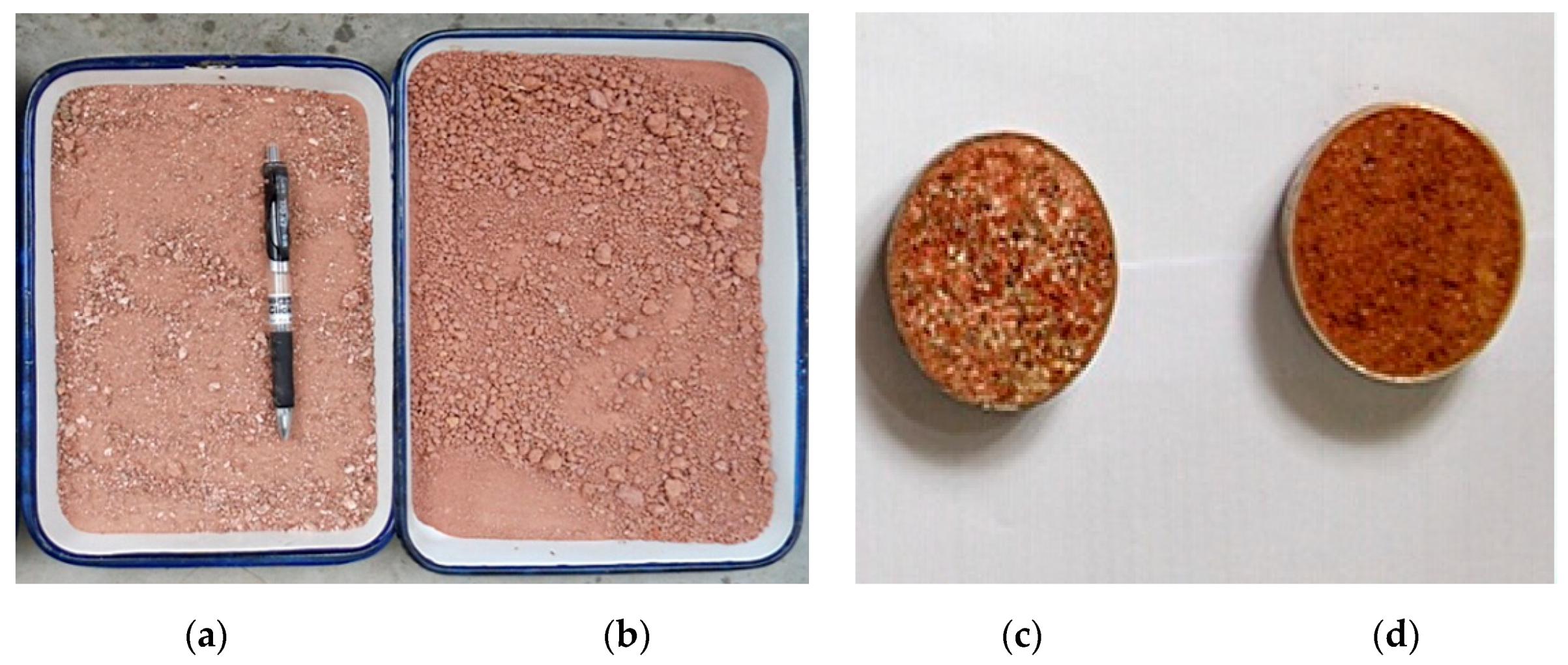
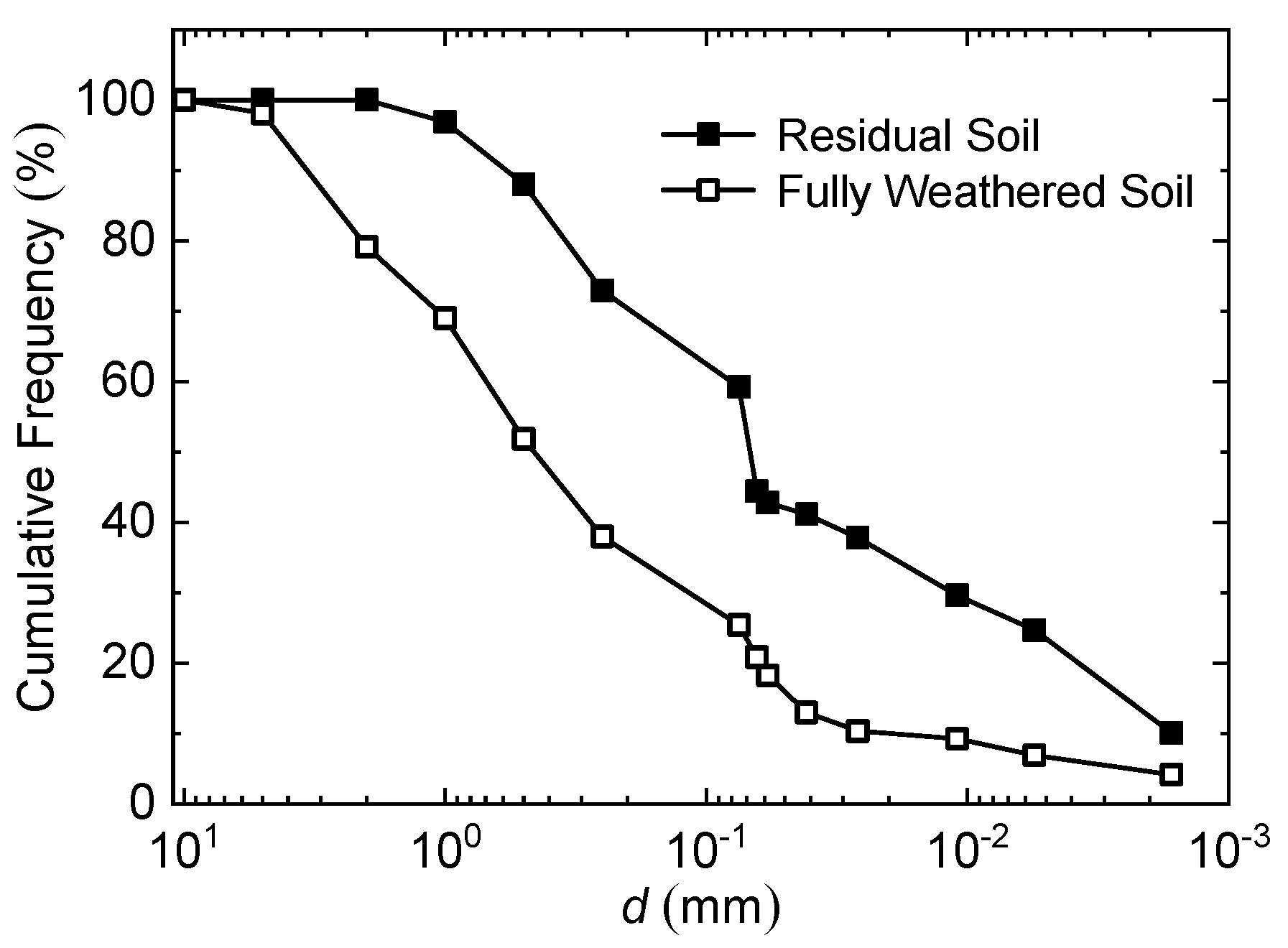

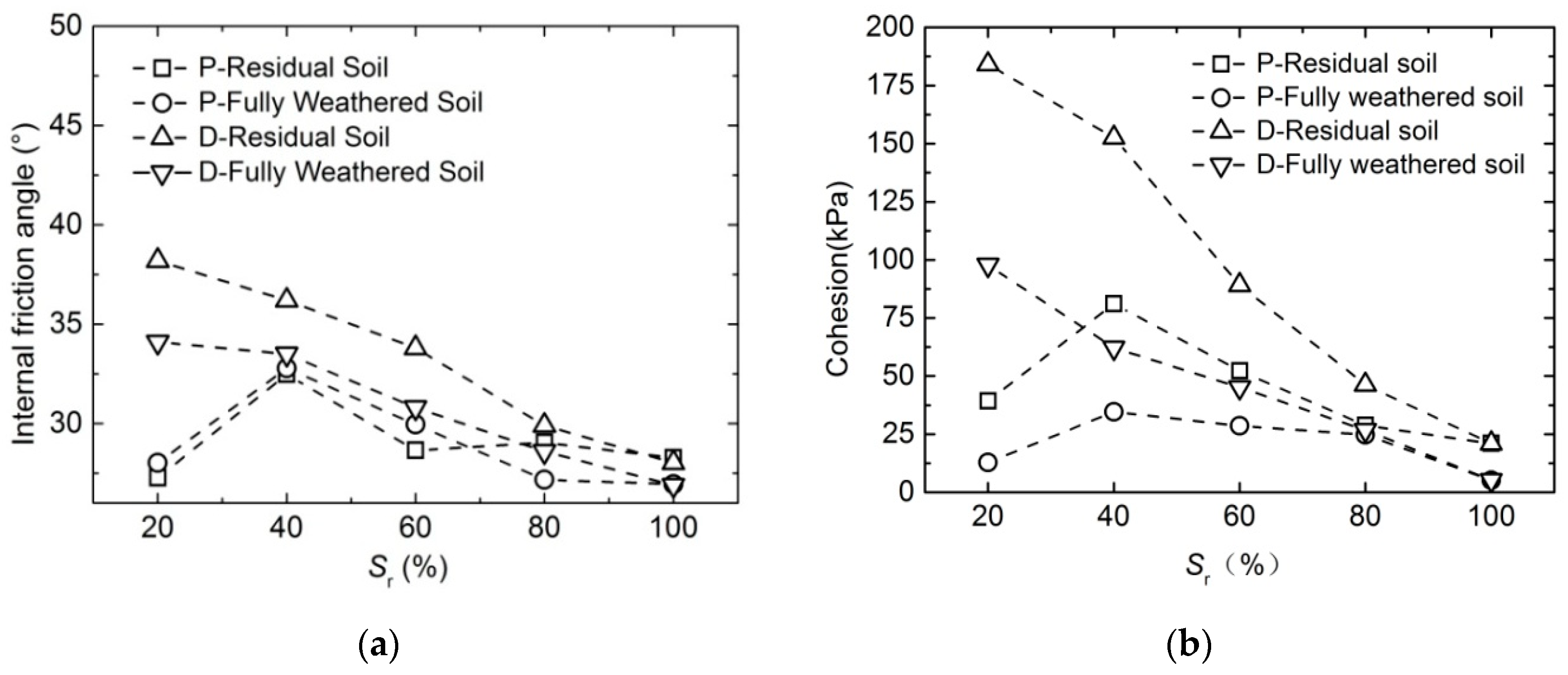
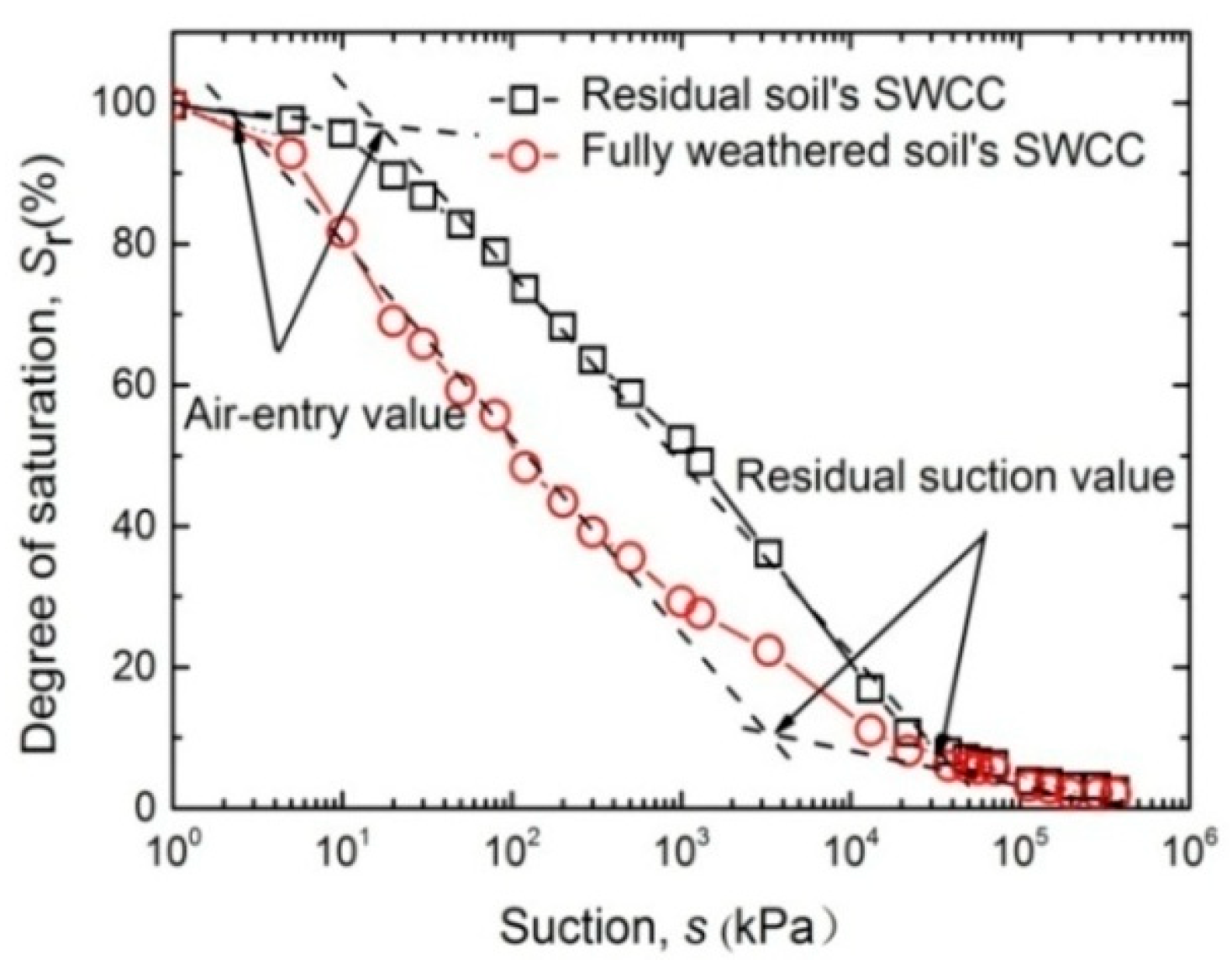
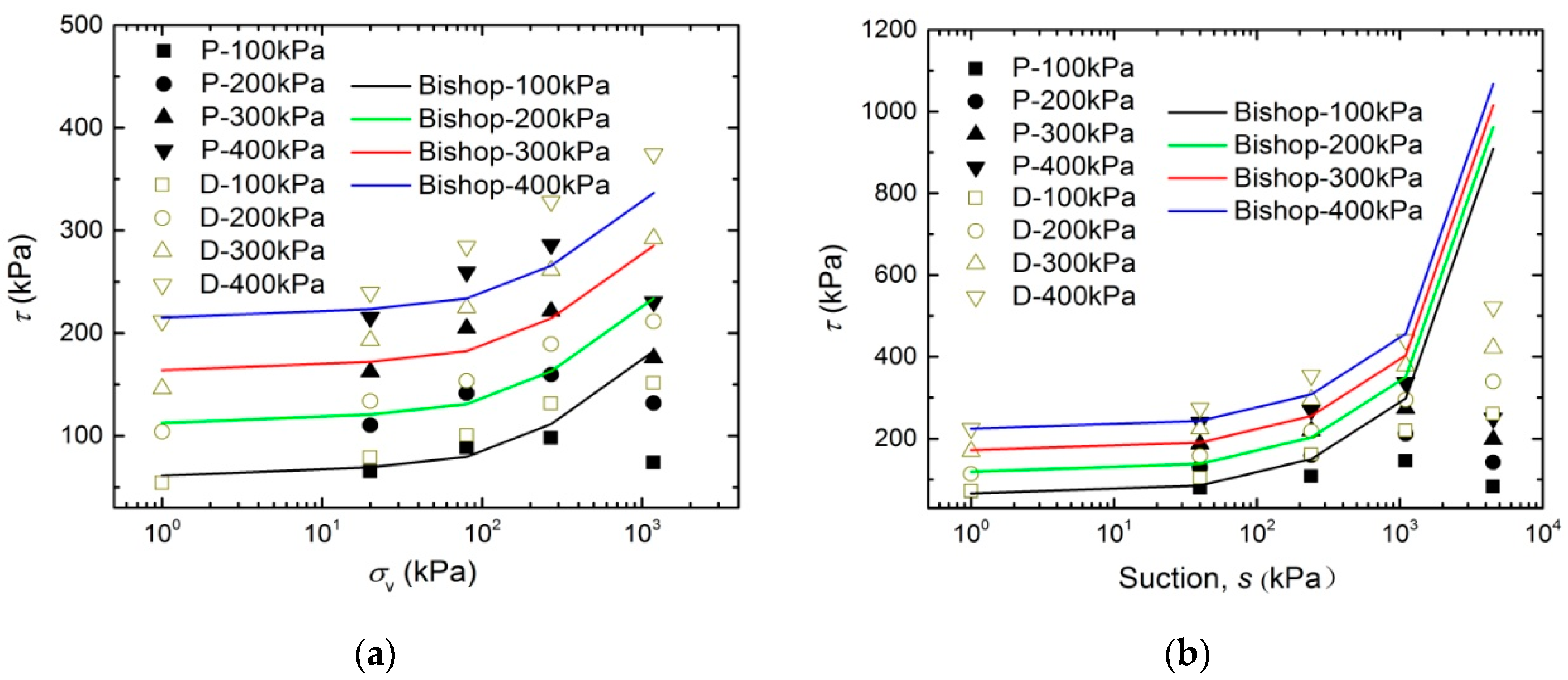
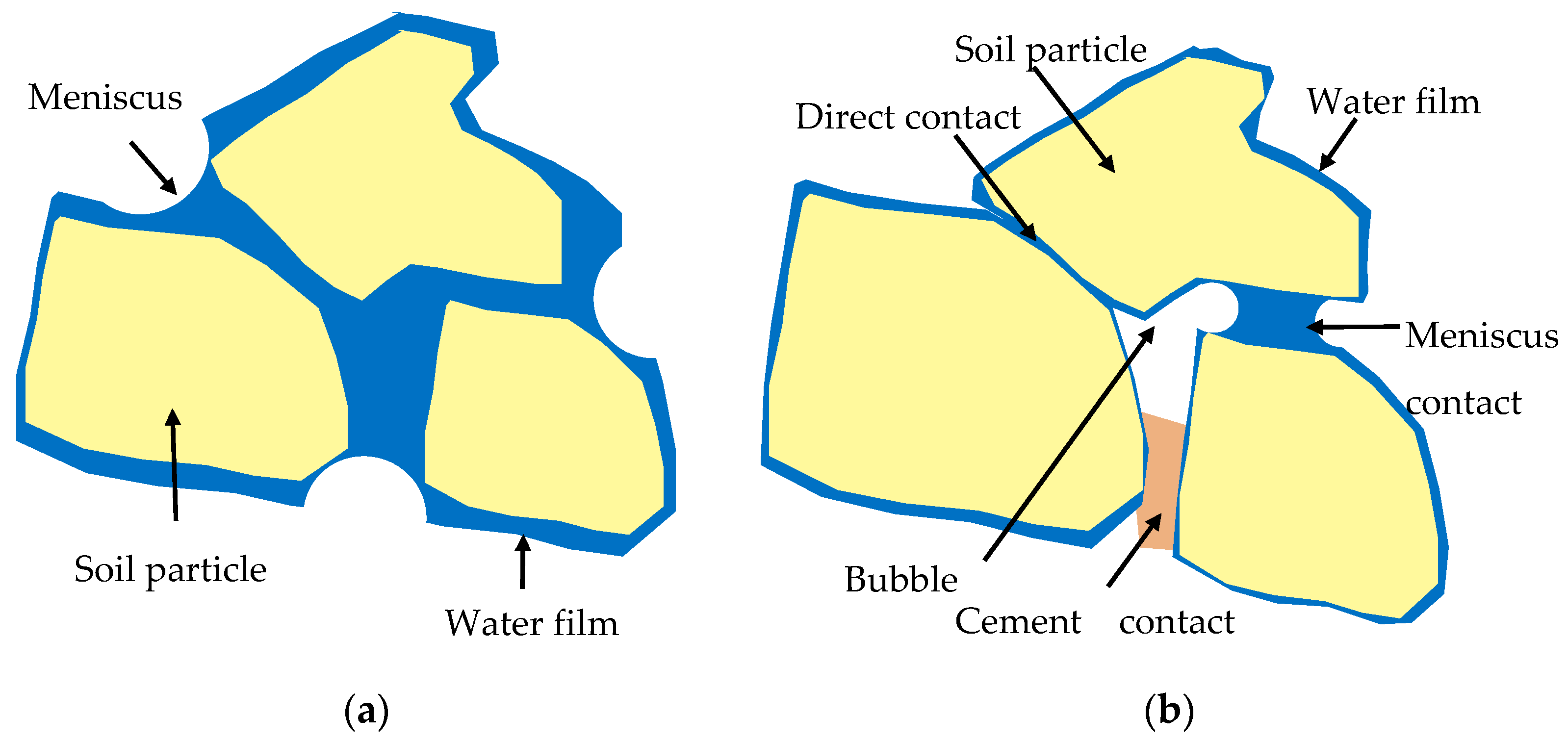
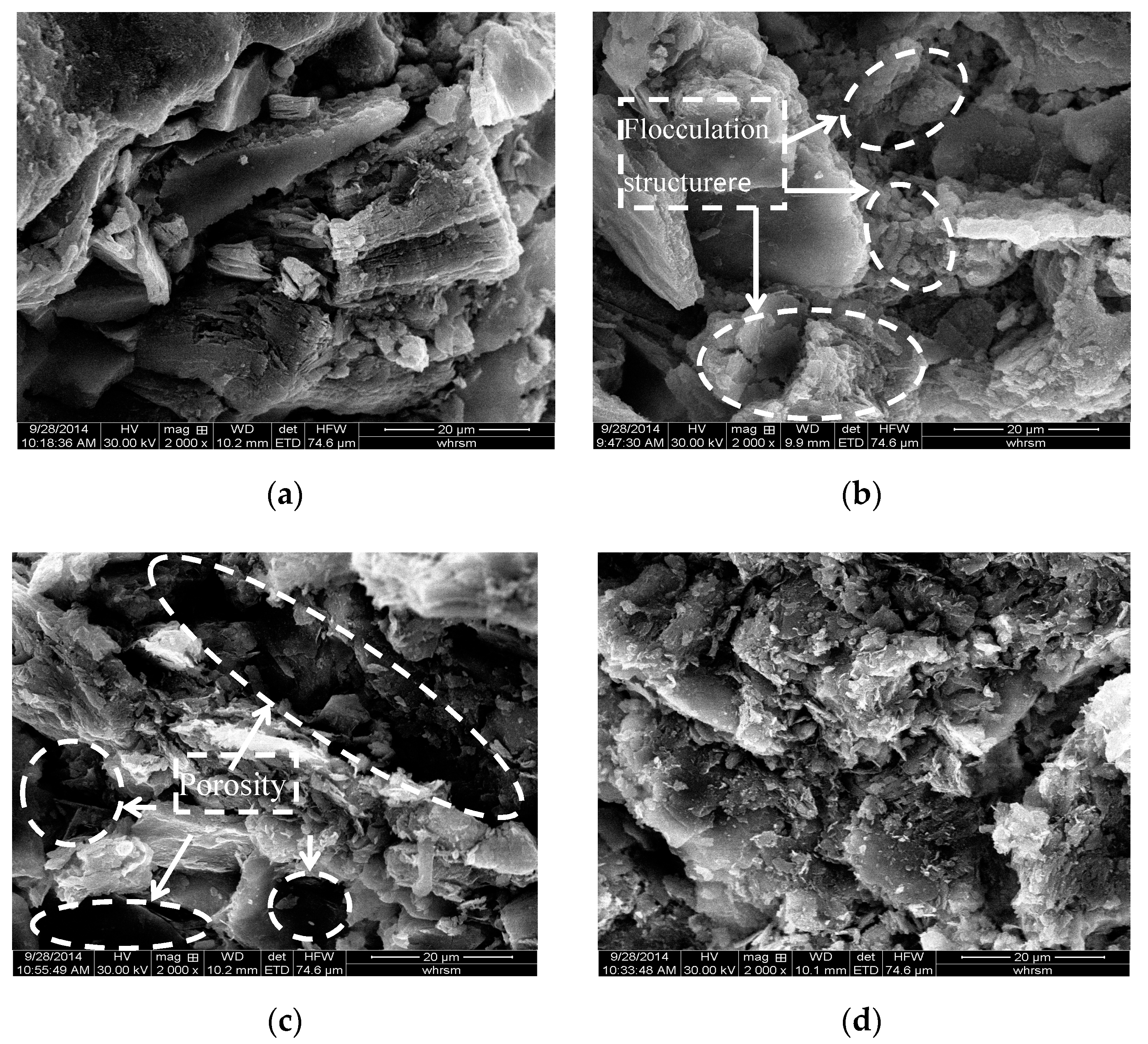
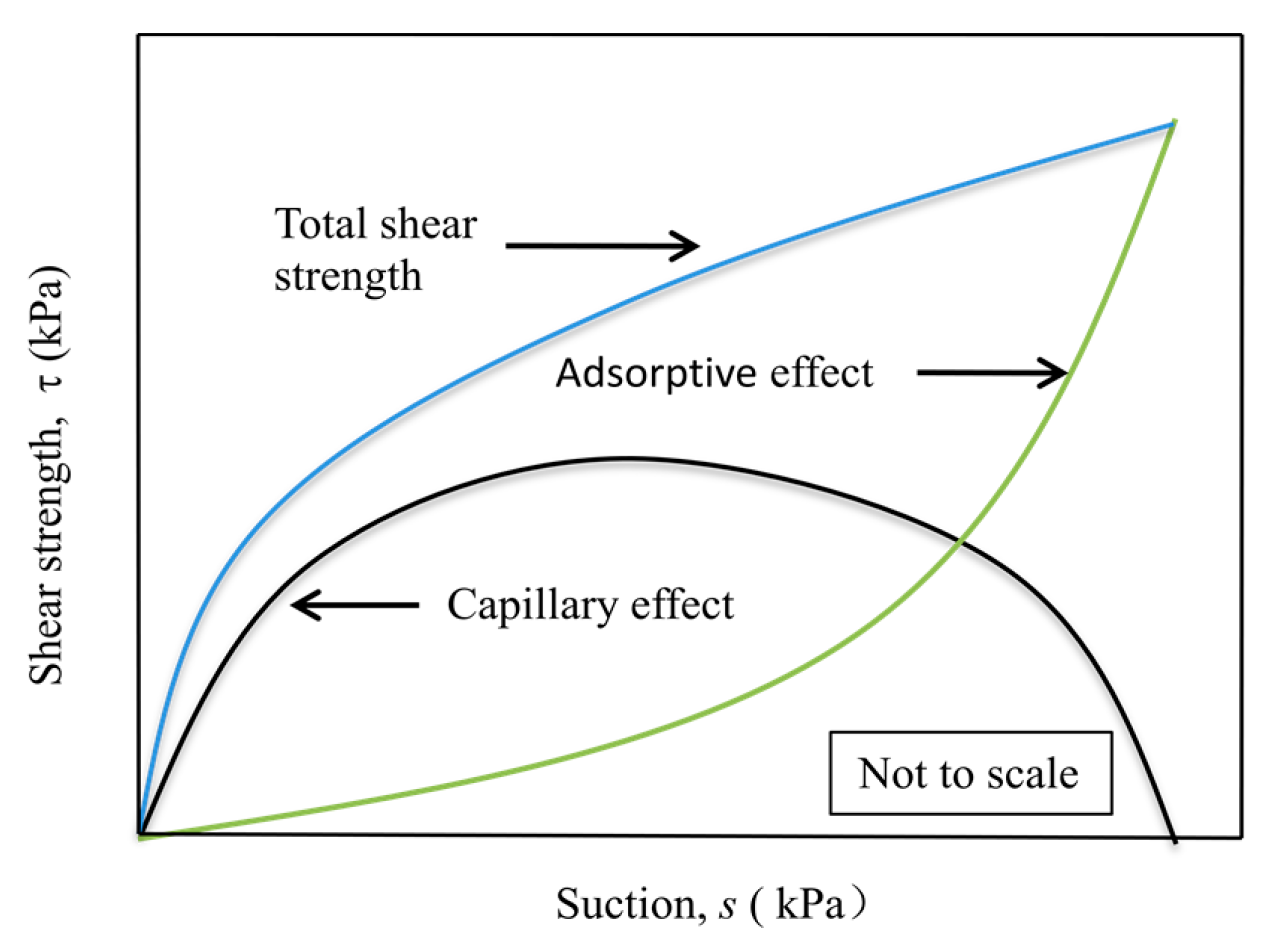
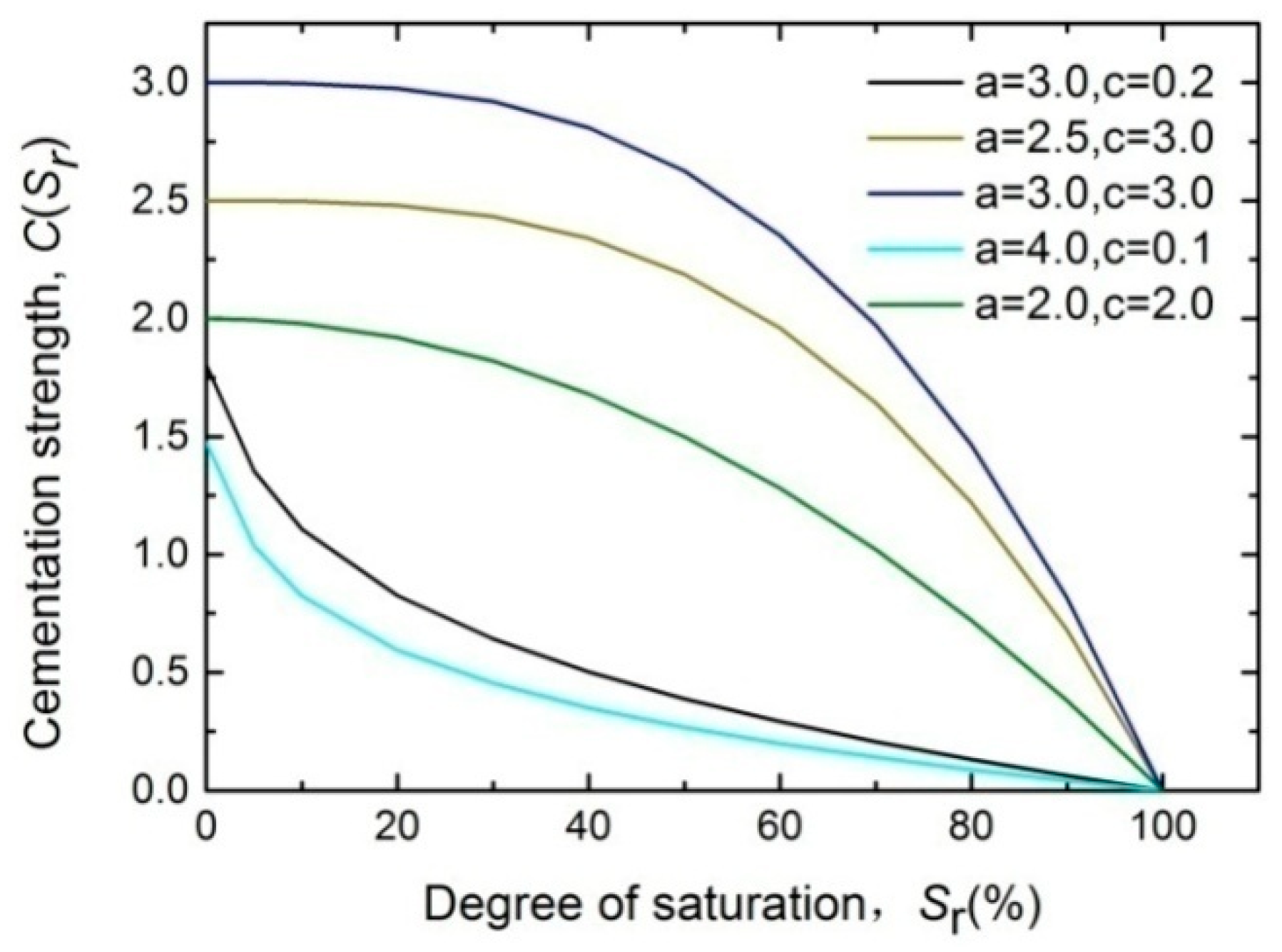
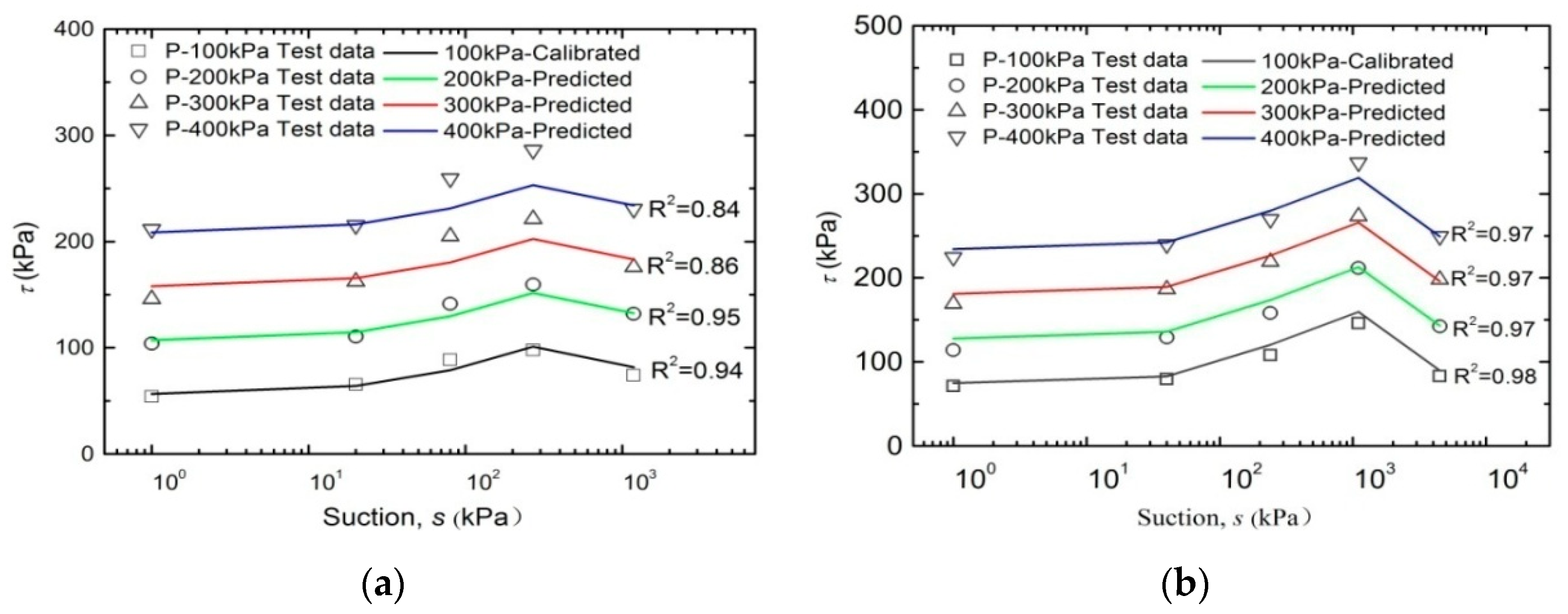
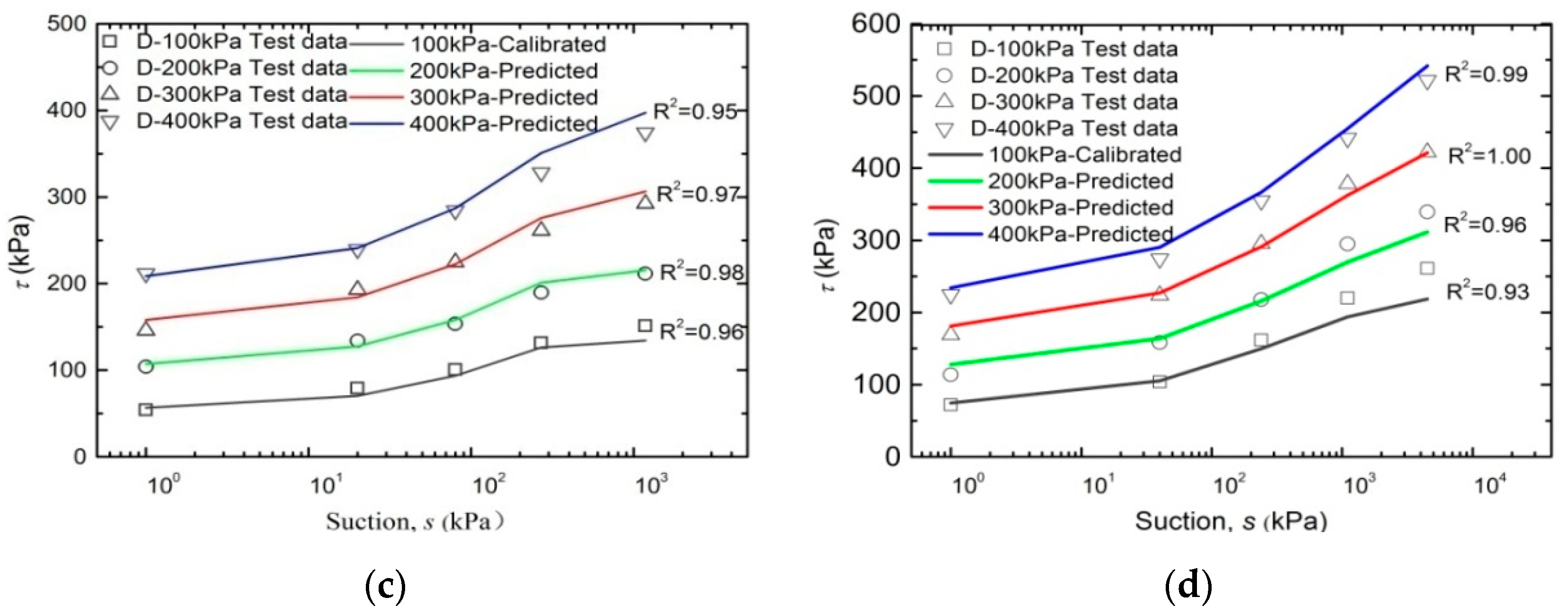
| Sample | Residual Soil | Fully Weathered Soil | |
|---|---|---|---|
| Property | |||
| Liquid limit | 55.8% | 43.7% | |
| Plastic limit | 30.3% | 28.6% | |
| Plasticity index | 24.5% | 15.1% | |
| Specific gravity | 2.71 | 2.66 | |
| Specific surface area (m2/g) | 107.2 | 70.2 | |
| Cation exchange capacity (meq/100 g) | 29.5 | 21.2 | |
| Sample | Residual Soil | Fully Weathered Soil | |
|---|---|---|---|
| Project | |||
| SiO2 | 69.83 | 68.28 | |
| Al2O3 | 16.91 | 16.36 | |
| Fe2O3 | 4.58 | 3.07 | |
| FeO | 0.19 | 1.14 | |
| K2O | 1.45 | 4.31 | |
| Na2O | 0.056 | 0.23 | |
| CaO | 0.017 | 0.032 | |
| MgO | 0.17 | 0.65 | |
| Loss on ignition | 6.57 | 4.97 | |
| Sample | Residual Soil | Fully Weathered Soil | |
|---|---|---|---|
| Parameter | |||
| c’ (kPa) | 20.98 | 5.22 | |
| φ (°) | 28.25 | 26.9 | |
| Sr,r (%) | 16 | 18 | |
| λ | 0.35 | 0.65 | |
| a | 4.5 | 2 | |
| b | 0.1 | 0.14 | |
© 2020 by the authors. Licensee MDPI, Basel, Switzerland. This article is an open access article distributed under the terms and conditions of the Creative Commons Attribution (CC BY) license (http://creativecommons.org/licenses/by/4.0/).
Share and Cite
Lu, Y.; Cai, G.; Zhao, C. The Shear Strength of Granite Weathered Soil Under Different Hydraulic Paths. Appl. Sci. 2020, 10, 6615. https://doi.org/10.3390/app10186615
Lu Y, Cai G, Zhao C. The Shear Strength of Granite Weathered Soil Under Different Hydraulic Paths. Applied Sciences. 2020; 10(18):6615. https://doi.org/10.3390/app10186615
Chicago/Turabian StyleLu, Youqian, Guoqing Cai, and Chenggang Zhao. 2020. "The Shear Strength of Granite Weathered Soil Under Different Hydraulic Paths" Applied Sciences 10, no. 18: 6615. https://doi.org/10.3390/app10186615
APA StyleLu, Y., Cai, G., & Zhao, C. (2020). The Shear Strength of Granite Weathered Soil Under Different Hydraulic Paths. Applied Sciences, 10(18), 6615. https://doi.org/10.3390/app10186615





